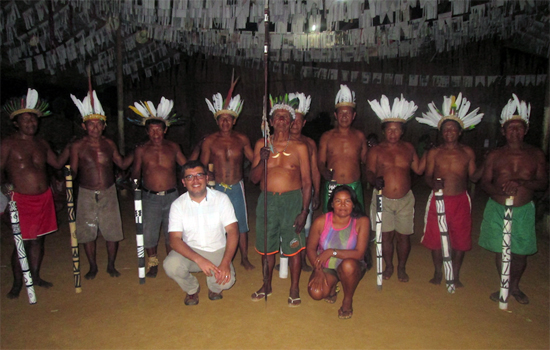RIT professor helps preserve languages of Amazonia
He sleeps in jungles to chronicle endangered languages of Brazil and Colombia
Photo provided
Wilson de Lima Silva (white shirt) with a Desano teacher, Maria Castilho, and villagers during his most recent trip to Brazil.
Wilson de Lima Silva, an assistant professor of linguistics at Rochester Institute of Technology, has received a three-year, $160,591 National Science Foundation grant to help preserve Siriano and Desano, two languages of the Tukanoan language family, spoken by only a few hundred people in northeastern Amazonia, in Brazil and Colombia.
Silva, a native of Brazil who speaks four languages, including some conversational Desano, began working in that region in 2006, when he began his Ph.D. work.
“I went to that region to look for a language to document,” he said. “I was informed by one of Brazil’s most famous linguists, Aryon Rodrigues, that there are languages there that are highly endangered which still need to be documented.”
Wilson, who works in the Sociology and Anthropology Department in RIT’s College of Liberal Arts, said there are an estimated 200 fluent speakers of Desano, but it’s difficult to get an accurate count of people who live primarily in jungle villages. To get his data, he travels three or four days on a river via motorboat, dodging rapids to get to those villages where he meets with Desano speakers and stay in the villages for a few weeks.
“They usually don’t have a house for outsiders to stay,” he said. “Sometimes I stay with a family, or they have a hut were I can hang my hammock.”
During his stays in the villages, he organizes workshops with Desano speakers and trains native speakers to document their language.
This past summer, Silva started to put together material for analysis comparing different dialects of Desano. Because indigenous Desano people live in different communities along different rivers, Silva wants to do a linguistic analysis of the language to understand language contact and change. The changes are due, in part, to having contact with speakers of other languages. “I was working with data to investigate any influence these other languages may have on Desano,” he said. He looked at different pronunciations and vocabulary and documented them in audio and video formats.
He said his work is needed because the native languages are endangered; many of the fluent speakers are in their 60s. “It’s important to document those languages before they disappear,” he said. “They shed light on human cognition and the human capacity to produce language. When a language is gone, we lose all that information. It’s like missing a piece of a big puzzle of what we’re capable to do in producing and using language.”
The Desano language is comprised of six vowels and 12 consonants. Silvas said the language has a complex set of markers called ‘evidentials’ that are used with verbs. In any statement made, the speaker needs to state the source of the information. “If I say it is raining in Desano, there’s an obligatory marker on the verb that indicates how I know that, if it is because of visual, hearsay or direct evidence,” he said.
He said Siriano is fluently spoken mostly on the Colombian territory by possibly only 100 to 150 people. “Siriano is closely related to Desano, and usually speakers of one say they can understand the other,” Silva said. “I’m investigating whether the two are different languages or dialects of the same language. The challenge is to find the fluent speakers to collaborate and participate in the project. In general, they are willing to participate in research with the goal to document and preserve their language.”
Silva directs the Field Linguistics and Language Documentation Lab in the Department of Sociology and Anthropology. He has four undergraduate students helping on the project, creating a database and digitizing materials. “I’m mentoring them in creating projects relating to this research,” Silva said. “The goal is to create an infrastructure for the work I’ve been doing for the project and involve RIT students in these activities.”
Silva plans to return to Colombia next year to continue his research.














